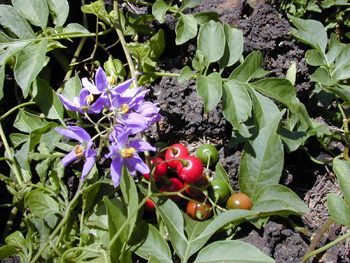Nightshades' Mating Habits Strike Uneasy Evolutionary Balance
October 22, 2010

Brazilian Nightshade (Solanum seaforthianum), a member of the Solanaceae family
Photo credit: Forest & Kim Starr
Most flowering plants are equipped with both male and female sex organs and many can fertilize themselves and procreate without the aid of a mate. But this may only present a short-term adaptive benefit, according to a study published in today's issue of the journal Science.
A team of biologists, which includes a biology professor at UC San Diego, report that long-term evolutionary survival of a species favors flowers that only use pollen from another plant.
"We've shown that a strong, short-term advantage experienced by individuals that have sex with themselves can be offset by long-term advantages to plant species that strictly avoid self-fertilization," said Boris Igić, an assistant professor of biological sciences at the University of Illinois at Chicago who headed the research team. The result is "an apparently unending competition between these two reproductive strategies," he said, "contributing to disparities in species diversity observed among different groups of plants."
The findings are reported in the October 22 issue of Science by Igić, and lead author Emma Goldberg, a postdoctoral research associate in biological sciences at UIC; Joshua Kohn, a biology professor at UCSD; Russell Lande of Imperial College, London; Kelly Robertson of UIC; and Stephen Smith of the National Evolutionary Synthesis Center in Durham, N.C. Lande is a former biology professor at UCSD and Igić and Goldberg were former graduate students at UCSD.
"One of the goals of evolutionary biology is to identify characteristics that cause some lineages to be evolutionarily successful and others not," said Kohn, who is also chair of the Section of Ecology, Behavior and Evolution at UCSD. "Here we have built a strong case that mating with others is such a characteristic."
Their study focused on Solanaceae, the large and diverse plant family commonly known as nightshades. It includes such important crop plants as potatoes, tomatoes and tobacco. Just under half of the known nightshade species cannot self-fertilize.
Goldberg and her colleagues measured the long-term effects of self-fertilization, which evolves from cross-fertilization - matings between different individuals - by frequent mutations and is difficult to lose once a plant acquires it. The researchers applied a mathematical model to calculate the rate of accumulation of species, also called the diversification rate.
"We found those species that avoid self-fertilization diversify faster, giving them a long-term advantage," Goldberg said.
"It's a trade-off," Igić added. "The short-term benefits of mating assurance and ability to invade a new environment are pitted against long-term advantages of greater genetic diversity, allowing plants that avoid self-fertilization to have more offspring during unpredictable environmental changes."
Avoiding self-fertilization also allows plants to more easily keep beneficial mutations and provides a degree of protection against some harmful mutations, Igić said. The findings underscore that both individual and species characteristics can strongly shape how a group of plants evolves and diversifies.
"The ability or inability to self-fertilize is subject to forces that act strongly, and in opposite directions," Goldberg said. "The balance between these opposing forces helps explain the diversity of plants within the nightshade family, and potentially many other plant groups."
Media Contact:- Kim McDonald (858) 534-7572; kmcdonald@ucsd.edu